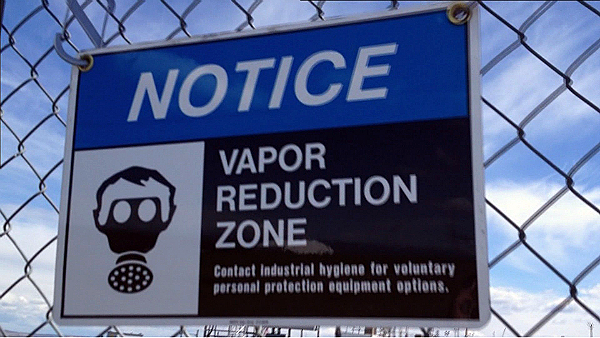UPDATED, July 22: On Friday afternoon, July 18, Washington River Protection solutions confirmed that two more workers were taken to the on-site medical equipment after reporting they had smelled chemical vapors. That incident, in the C tank farm, brings the total number of workers affected since March to 42.
--
Original story filed July 17:
Two workers at the Hanford Site were exposed to suspected chemical vapors on Thursday, sending one to a nearby hospital and another to the on-site medical clinic.
The incident happened around 7:15 a.m., according to a statement issued by Washington River Protection Solutions, one of the private contractors performing clean-up work at Hanford. The statement said the worker who received treatment at the on-site clinic returned to work later in the day.
According to other workers who witnessed the incident, the two people who received medical attention were working outside of the A tank farm and were not wearing respirators. A group of workers inside A farm saw one of the two fall to the ground, after which they called for assistance. None of the workers in the group that witnessed the incident was affected; all of these workers were wearning respirators.
That brings to 40 the number of workers who, since mid-March, required some sort of medical attention after reporting being exposed to chemical vapors escaping from huge tanks holding nuclear waste.
Just last week the U.S. Department of Energy took reporters on a tour of the site to showcase safety precautions and to report that none of its own studies had detected chemical vapors this year. Energy officials did not rule out vapor exposure as a possible cause of the workers' conditions, but stressed that no air monitoring tests had picked up signs of chemical in the air at the site.
Our workers are not exposed to vapors, but they are having symptoms, said Energy official Tom Fletcher last week. The question is: 'Why?' ... This isn't something we are taking lightly.
Government studies have found nearly 2,000 toxic chemicals inside the tanks -- the leftovers from the messy work of plutonium production during the Second World War and the Cold War. Caustic chemicals were used to melt uranium fuel rods from nuclear reactors at the site, then small amounts of plutonium were removed from the dissolved fuel.
Waste from the process was pumped into 177 tanks. Decades later, it remains deadly and will continue to be until the technology is developed to permanently dispose of it. The waste, hot from radioactive decay, vents toxic vapors at irregular intervals. While special filters keep radiation from escaping from the tanks, the toxic gases pass through unstopped into the atmosphere around the tank farms.
One worker who told his story to KING 5 in April was not convinced by the Energy Department's message last week. Steve Ellingson said he still has a hard time catching his breath after he was exposed to chemical vapors in March. The veteran Health Physics Technician said he was exposed whether the equipment showed it or not. He said the are monitoring gadgets in use at Hanford do not test for every chemical that could be in the farms and are not attached to individual workers.
Other Hanford workers gathered in Richland on Wednesday night for a forum on the vapor issue sponsored by the watchdog group Hanford Challenge. According to KEPR TV, workers at the meeting call the vapor incidents this year an epidemic. With little they say being done by their bosses, they're banding together looking for solutions to stay safe.
Watch the KING 5 series, The Human Toll of Hanford's Dirty Secrets.
KING 5's Russ Walker contributed.


